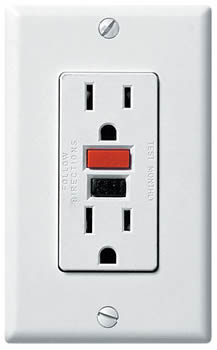 Question: In the past you’ve written about special outlets for the garage. What should I install? I’m selling my house to my son and I want everything to be safe.
Question: In the past you’ve written about special outlets for the garage. What should I install? I’m selling my house to my son and I want everything to be safe.
Answer: Your question is timely because I recently had an angry seller call me insisting that I replace the outlet in his garage because, as he said, “You broke it.” What you are referring to is a ground fault interrupter. The purpose of the GFCI is to protect people against accidental shock when they are in a damp or wet environment.
In the early 1970s, the National Electrical Code began to require GFCI outlets or a GFCI circuit breaker for all residential exterior outlets near the ground.
Over the years the codes changed to add GFCI protection to the outlets in the bathrooms, kitchens, garage and at lest to the one in an unfinished basement.
There were expectations to the garage outlets such as one marked “freezer only” and outlets on the ceiling for garage-door openers.
All circuits in your home are protected by either a fuse or breaker. These safety devices will blow up or trip if there is a direct short or if a breaker overheats. A GFCI outlet or breaker monitors current flowing through the hot and neutral wires of the outlet. If the GFCI detects an imbalance in the flow of the current as low as 5 milliamps, it will trip faster then you can blink in about 1/20 of a second.
GFCIS are so sensitive to change in the flow of current that they often trip “off” when connected to a fluorescent light fixture or to a motor circuit found on a refrigerator or freezer. The existing outlets in your home can be replaced with a GFCI protection.
Find the first outlet on the wiring coming from the main electric panel and it will protect the remaining standard duplex outlets downstream from the GFCI. This is called the “load” as it is marked on the back of each GFCI outlet. If your home has the older two-pronged outlets (no third hole for a ground), a GFCI can still be installed to protect that single outlet.
GFCIS require monthly maintenance to ensure that the inner workings of the outlet are responsive and will work when needed. It is recommended that the GFCI outlet or breaker be tripped once a month and then reset. If it does not trip off it needs to be replaced. Sometimes you will find one that will trip off but cannot be reset, and that, too, needs to be replaced.
In that particular home that I inspected, there was a cord from a refrigerator blocking the buttons on the front of the GFCI. If the reset button is blocked and cannot move, the GFCI will not trip off even in an emergency. This was a very dangerous situation and I’m sure that the GFCI was not tested monthly. The homeowner should have been thankful that I found the detective GFCI and possibly prevented a serious accident. -SHNS

